6 Types of Aspen Trees to Identify on Your Nature Walks
Author: Jen Worst | Editor: Omar Alonso
Review & Research: Jen Worst & Chris Miller

All of the types of aspen trees are a beautiful and quite popular addition to the landscape in the Northern United States and some regions in Canada. They are characterized by their gorgeous white bark and stunning yellow leaves in autumn.
Belonging to the genus populous, aspen trees have toothy and triangular leaves reminiscent of the leaves of trees such as cottonwood and poplar, which also share the same genus.
Down below, we will discuss the aspen tree varieties you're most likely to find and everything you need to know about these beautiful trees.
More often than not, if you find many aspen trees growing next to each other, know that they belong to the same underground root system.
6 Types of Aspen Trees
Although aspen trees grow pretty quickly, the life span of aspen trees is on the shorter side, averaging about 5 to 15 years. The roots keep growing new plants from the dead tree through origin suckering.
These rootstocks keep on growing new trees for thousands of years. As a result, the trees grow healthy with well-defined trunks as long as adequate sunlight and space are there.
Let's read more insights about the different types of aspen trees without further delay.
Quaking Aspen Tree
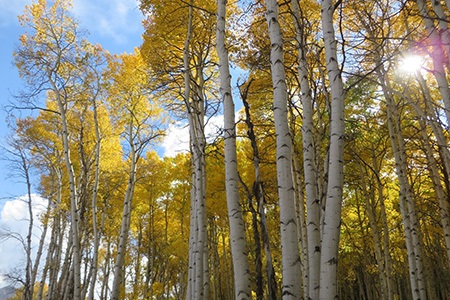
Quaking Aspen, scientifically referred to as "Popular tremuloides," is among the most popular type of aspen trees. They are also called trembling aspen trees because they tremble or flutter on windy days and sometimes even in a light breeze.
As they are native to both of the coasts of America, they have evolved to be able to handle freezing weather. Their heavy resistance to cold has made them suitable for growth even in the harshest climate of Canada.
The barks of these trees are gray to greenish-white in color with a relatively smooth texture. Black horizontal markings are found all over the trunk and dense black knots. Like the many types of elm trees, these grow very tall and wide as they mature.
Unlike most other trees belonging to the same genus, Quaking Aspen trees do not have pointed leaves with outward pointed teeth. Instead, they have rounded edge leaves. As a result, the leaves change color from a vibrant green in the summer to a striking yellow in the fall.
The Quaking Aspen tree species is quite a tall tree, and they grow to maturity reasonably quickly. They grow up to be around 20-80 feet tall, and their trunks can grow to be 3 to 18 inches in diameter.
However, putting their beauty aside, they may pose severe threats to drainage pipes and sewers due to their root network and root suckering.
Chinese Aspen Tree
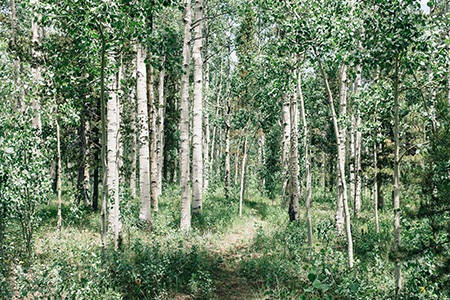
As it can be guessed from the name, the Chinese Aspen "Populus Adenopada" is native to China. Moreover, China's mountains are home to many of these aspen varieties.
These flowering deciduous trees are characterized by pale-grey tree bark. The leaves have a smoother texture than other aspen leaves and are egg-shaped. The bark of this tree is known to turn into darker grey with a rough surface when it ages.
The color content of the leaves in Chinese Aspen trees includes bright shades of green that pop out vibrantly under sunlight.
While circular leaf borders contain microscopic edges, other kinds of Chinese Aspen have rectangular leaf petals with rounded edges. As a result, the green shades convert into warm yellow tones over time when fall comes.
Typically, the Chinese types of aspen trees grow up to about 900 feet. They are most likely to grow on mountain tops or slopes about 300 to 3,000 meters high. These trees grow best in moisture-rich soils.
Chinese aspen trees are one valuable species of trees. They are one of the primary raw materials used to process furniture and house construction work. Moreover, the pulp and timber are exceptionally rigid, making them an excellent material for making wooden tools.
European Aspen Tree
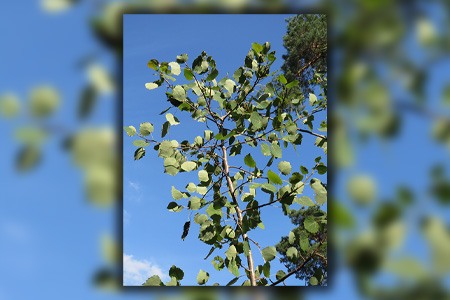
The "Populus Tremula," more commonly known as European Aspen, is one of the most geographically diverse and spotted varieties of aspen trees. Native to Northwestern Europe, Siberia, and Africa, this aspen has spread globally to Japan and the Arctic region.
Their bark has a silvery gray color with a nice and smooth texture, and with age, diamond-shaped pores appear on the bark. Like the Quaking Aspen, they tremble and flutter even in the slightest presence of wind.
The constant rustling of leaves can be heard for miles even if the trees are not visible. The leaves on the European Aspen have a rounded edge and are coarsely toothed, and measure around 3 inches in length.
These aspen tree varieties start with a copper-bronze color and slowly mature into gray-green like certain types of hemlock trees until finally turning into a spectacular shade of yellow in autumn.
European Aspen trees usually grow up to about 30 to 80 feet tall, while their bark has a diameter somewhere between 10 to 30 feet wide. Ideally, they thrive under direct sunlight and rich, moist, and well-drained soil. New groves and shoots sprout of old or dead tree roots frequently due to its quick root suckering.
Korean Aspen Tree
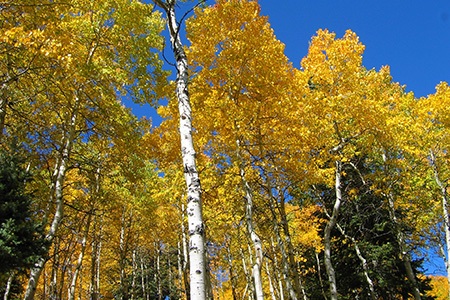
Known by the scientific name of "Populus Davidian," the Korean aspen tree originated in Asia. They are characterized by their flourishing foliage that creates a circular crown.
Korean aspen trees showcase spherical leaves which are bright green. The trees have white-grey barks which have a smooth texture, but the basal segment of the bark is stiff and rigid.
However, the lighter barks are accompanied but dark-tinted branches that make the tree look visually pleasing with a blend of all shades, like giant types of ficus trees.
Additionally, flowers swing all around the tree way before leaves grow, and tiny cotton-like seeds grow alongside the leaves.
The leaves of Korean types of aspen trees have oval surfaces and are thin with edgy tips. They are red, but as they mature over time, they turn green and then golden yellow during the fall season.
Moreover, the leaves also have intricate margins that makeup up an edgy end, making them look triangular. This is one of the features that makes Korean Aspen leaves distinguishable from other tree leaves.
For the heights, Korean aspen tree species usually grow up to 25 meters in height with about 60 centimeters of diameter for the trunk. The trees grow best in well-drained and moisture-rich soils.
Bigtooth Aspen Tree
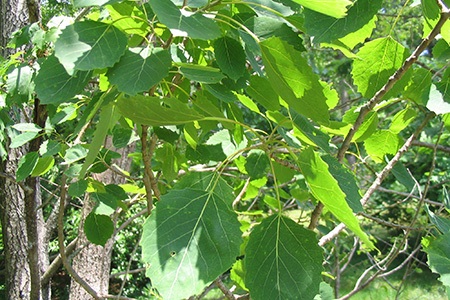
"Populus Grandidentata" or the Bigtooth Aspen (also referred to as Largetooth Aspen and American Aspen) is native to North-Central America and Southeastern Canada. They are not as geographically well spread as the Quaker and European Aspen and are also less adaptable.
Grandis means "large," and data means "toothed," which is self-explanatory when looking at their leaves. They have leaves with relatively larger teeth than most other aspen trees.
They have thin barks with a smooth texture when they are young. The bark turns from light olive green to a more mature gray upon maturity, while the bark grows rough with grooves and knots.
The wood from this tree is fine-grained and has a light shade. It is also straight-textured and soft. They can be used for structural panels and particle boards but are more commonly used for wood pulp.
The bark is pelletized as well for fuel and cattle supply. Some other uses include hockey sticks, ladders, and cricket bats.
Bigtooth Aspen varieties thrive in flooded plains, well-drained and moist soils. Under ideal conditions, they can grow up to 60 feet tall and around 20 inches in diameter. They grow pretty quickly and generally rise around other aspen species.
Japanese Aspen Tree
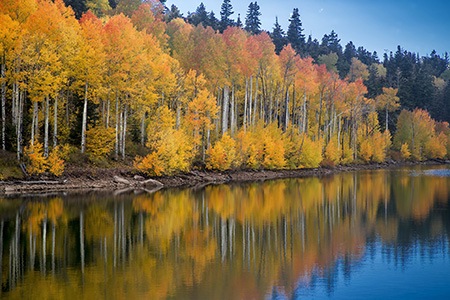
Japanese Aspen trees, also known by the scientific name "Populus Sieboldii," are aspen trees that are famous for their oval-shaped leaves with pointy ends that make up their beautiful foliage.
These deciduous types of aspen trees are featured by their white-grey barks and their roots spread around 40 feet or more. Japanese aspen trees most commonly grow around mountainous regions.
Japanese aspens grow best in moisture-rich soil and damp conditions. They do not extend to their full potential in sunny areas. When you find them growing amongst a forest of various types of cedar trees, you'll find them along the edges where they can enjoy partial shade.
As for its uses, Japanese aspen tree extracts are used as a plant hormone for other trees. In addition, wood from Japanese Aspen is low flammable, making them an excellent material for making tools and other similar textured things.
These aspen tree varieties have a fantastic maturity rate where they grow super-fast to a maximum of 65 feet. However, while Japanese Aspen has its beauty and traits, planting it around city buildings is not wise since the roots can climb up its walls.
Types of Aspen Trees to Spot During Autumn
If you plan to bring and plant aspen tree species in your yard or garden, make sure you plant in an area where sunlight does not fall directly. Aspen trees are not tolerant to heat and grow best in damp areas with well-drained soil.
And that brings us to the end of the discussion about the different types of aspen trees. While these trees are mostly planted due to their rapid growth rate by forest officers, you can grow them for gardening purposes as well.



